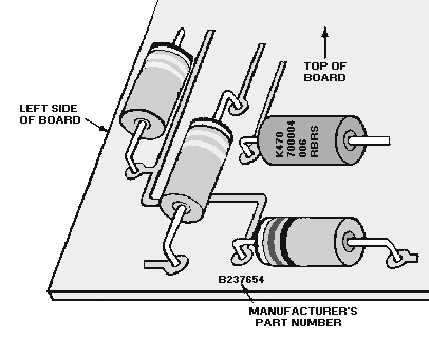3-22
Figure 3-15.—Component arrangement.
When possible, component identification markings should be visible after installation. If you must
choose between identification and electrical value markings, the priority of selection is as follows: (1)
electrical value, (2) reliability level, and (3) part number.
Components are normally mounted parallel to and on the side opposite the printed circuitry and in
contact with the board.
FORMATION OF PROPER LEAD TERMINATION.—After component leads are formed and
inserted into the board, the proper lead length and termination are made before the lead is soldered.
Generally, if the original manufacturer clinched (either full or semi) the component leads, the replacement
part is reinstalled with clinched leads.
When clinching is required, leads on single- and double-sided boards are securely clinched in the
direction of the printed wiring connected to the pad. Clinching is performed with tools that prevent
damage to the pad or printed wiring. The lead is clinched in the direction of the conductor by bending the
lead. The leads are clipped so that their minimum clinched length is equal to the radius of the pad. Under
no circumstances does the clinched lead extend beyond the pad diameter. Natural springback away from
the pad or printed wiring is acceptable. A gap between the lead end and the pad or printed wiring is
acceptable when further clinching endangers the pad or printed wiring. These guidelines ensure uniform
lead length.
Q14. To what standards should a technician restore electronic assemblies?
Q15. How is oxide removed from pads and component leads?
Q16. Leads are formed approximately how many degrees from their major axis?
Q17. When you replace components, identification marks must meet what requirements?

